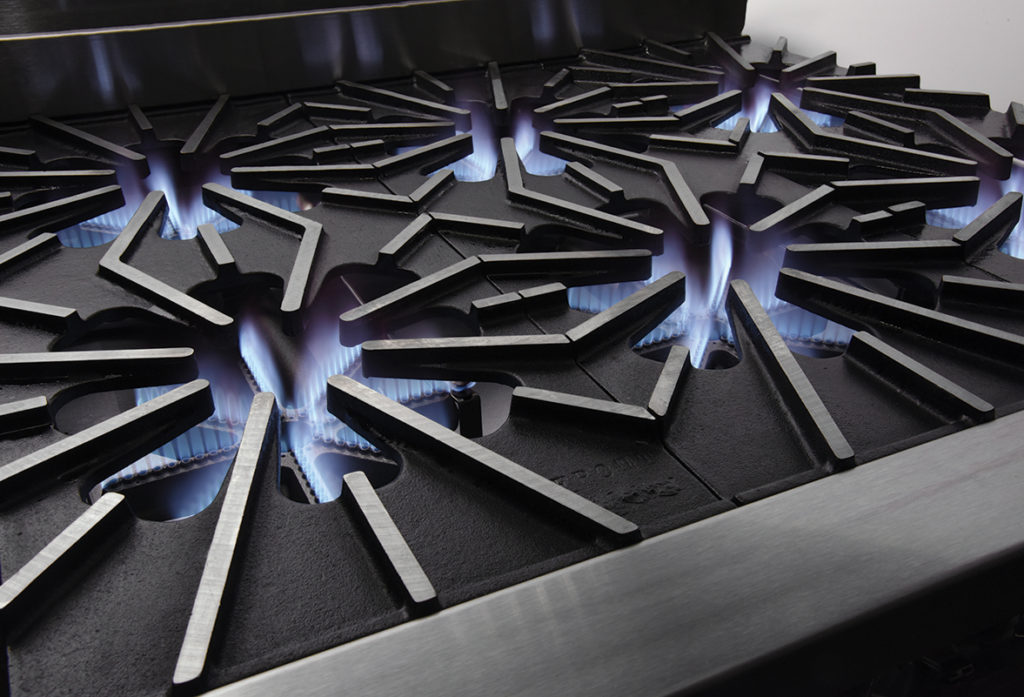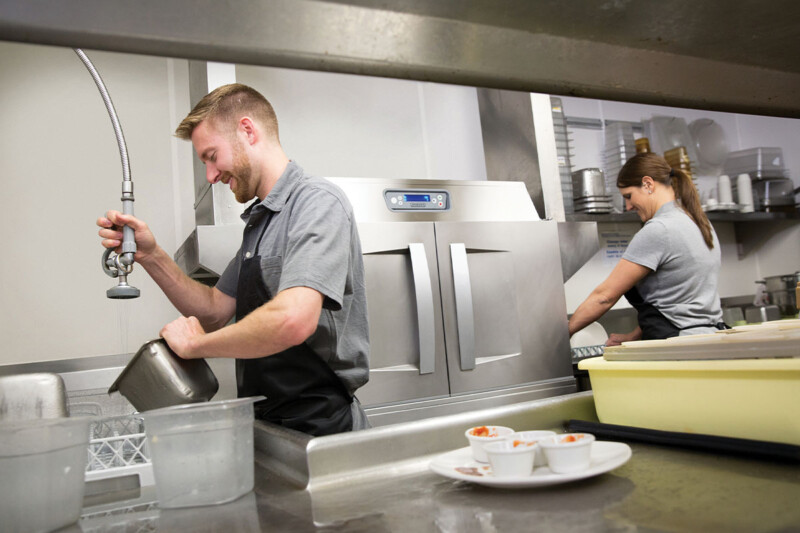
When it comes to versatility, few pieces of kitchen equipment rival the range. Depending on the configuration, ranges let you sauté, pan-fry, grill, boil or broil on top, and bake, refrigerate or store below. Which one is right for you? Hoo, boy. So many options…
First of all, commercial ranges generally come in two styles: medium-duty (aka restaurant ranges) and heavy-duty (hotel ranges). Main differences include construction materials, Btu output, durability and cost.
Medium-duty ranges are stand-alone units perfect for daily use in small to midsize restaurants. One manufacturer refers to these ovens as utility pieces that do it all. How much “all” your kitchen puts out each day, though, is a huge factor in choosing a medium- or heavy-duty range. The purchase price may be less than a heavy-duty range and service might be less expensive, but make sure you’re not underbuying performance just for the sake of price.
For larger operations or those smaller kitchens with heavy customer demand, heavy-duty ranges sport higher density steel and higher Btu output for durable, high-volume cooking around the clock. Heavy-duty ranges work as stand-alone pieces or can join with other equipment on a cookline with side gas connections.
Both types come in a variety of standard widths, most commonly 24-, 36-, 48-, 60- and 72-in. At least one manufacturer also offers 34-in.-wide heavy-duty ranges.
Gas Or Electric
Utility preference also adds to the available choices. Ranges come in electric and gas models, the latter including both natural gas and liquefied petroleum gas (LP). While makers say that gas models are the most common, electric ranges work well in areas where gas is not available or electricity is cheaper.
Electric burners also are more efficient. According to one maker, the efficiency of gas burners is somewhere in the 30%-40% range while electric burners rate in the 70% range. Newer induction burners are most efficient, with percentages in the high 90s. Btu output is an important factor in your choice, but so is the unit’s efficiency rating.
If you choose gas burners, be sure to follow the manufacturer’s recommendations when it comes to keeping the burner ports clean. This will ensure the burners continue to deliver the rated Btu power. Several makers offer anti-clog burners.
While utility cost and availability are important variables in choosing the right range, manufacturers say the decision mostly comes down to chef’s preference.
The Right Combination
Your range top reflects your menu and cooking styles. Want all burners? You can do that. Do you offer eggs, pancakes and other breakfast items? Consider losing some burners and adding a griddle. Serve a lot of steaks and chicken? Think about a charbroiler for all or part of your range top. For meat-heavy menus, consider adding a broiler or salamander to your range.
Additional range top options include:
– Hot tops, which are flat surfaces for pots and pans (but not for cooking food directly on the surface like a griddle). Hot tops keep the highest heat in the center and rather than limiting you to a one-pot-to-one burner ratio, they transfer heat to as many pots and pans as you can fit on the surface;
– French tops, also smooth surfaces made of concentric rings with highest heat in the center that also let you slide pots and pans to different temperatures across the surface; and
– Induction griddles, which provide the most efficient heat transfer to the cooking vessel and a cooler work environment.
Choices abound below the range top, too. Your range base may include an oven or two, or storage (refrigerated or ambient).
Ovens are either “standard,” which are at least 26-in. wide, depending on the size of your range, or “space saver,” which generally measure 20-in. wide and 26-in. deep. Standard ovens let you put in full-size sheet pans both lengthwise or widthwise. The narrower measure on space-saver ovens means pans will only fit one way.
Manufacturers caution that operations that do a lot of baking should consider using a dedicated convection oven for baked goods rather than range ovens, whether standard or space saver. It’s essential that you take the time to study your menu as well as any potential future menu items when specifying the right combination of cooking options on a new range. Once crews install it, you can’t change the configuration.
Mistakes, Misconceptions
What are some common mistakes operators make when buying a new range? One maker says a common error is not paying attention to the type of gas the facility uses, with disappointed operators getting an LP gas range delivered to a building that uses natural gas.
Another common mistake is buying a range with a storage base but wanting an oven when the unit arrives. One manufacturer asks clients to sign off when they specify a storage base to ward off buyer’s remorse.
Operators sometimes confuse hot tops with French tops, says one manufacturer. French tops provide higher, more direct heat to pots and pans for boiling while hot tops are better suited for simmering, but both reach hotter temperatures in the center than on the edges. Knowing how you intend to use your range top prevents ordering a top less suited for your needs.
Before ordering a heavy-duty range with high Btu burners, add up all of the Btus and make sure your gas line regulator can handle all burners being used at the same time.
Range manufacturers agree that there is no magic formula for determining which type is right for your operation. Rather, they strongly suggest working with a consultant, dealer or manufacturer to discuss menu, demand, preferred cooking methods and other variables.
RELATED CONTENT
- Advertisement -
- Advertisement -
- Advertisement -
TRENDING NOW
- Advertisement -
- Advertisement -
- Advertisement -


